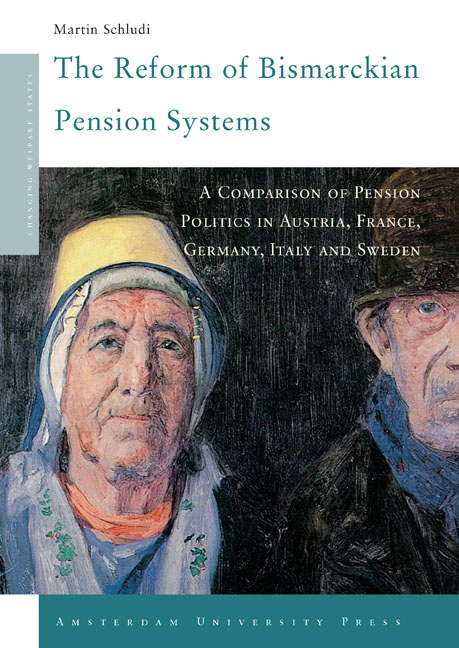 The Reform of Bismarckian Pension Systems
The Reform of Bismarckian Pension Systems Book contents
- Frontmatter
- Contents
- List of Tables/List of Figures
- Acknowledgements
- Introduction
- 1 The Need for Pension Reform:A Problem-Oriented Perspective
- 2 An Empirical Overview of Policy Change in Bismarckian Pension Regimes
- 3 The Politics of Pension Reform:An Actor-Centred Explanatory Framework
- 4 Sweden:Policy-Oriented Bargaining
- 5 Italy:Corporatist Concertation in the Shadow of EMU
- 6 Germany:From Consensus To Conflict
- 7 Austria:Reform Blockage by the Trade Unions
- 8 France:Adverse Prerequisites for a Pension Consensus
- 9 Conclusion
- Appendix I Summary Description of Retirement Systems (1986)
- Appendix II Chronology of National Pension Reforms
- Appendix III Glossary of Terms
- Notes
- Bibliography
- Index
7 - Austria:Reform Blockage by the Trade Unions
Published online by Cambridge University Press: 24 January 2021
- Frontmatter
- Contents
- List of Tables/List of Figures
- Acknowledgements
- Introduction
- 1 The Need for Pension Reform:A Problem-Oriented Perspective
- 2 An Empirical Overview of Policy Change in Bismarckian Pension Regimes
- 3 The Politics of Pension Reform:An Actor-Centred Explanatory Framework
- 4 Sweden:Policy-Oriented Bargaining
- 5 Italy:Corporatist Concertation in the Shadow of EMU
- 6 Germany:From Consensus To Conflict
- 7 Austria:Reform Blockage by the Trade Unions
- 8 France:Adverse Prerequisites for a Pension Consensus
- 9 Conclusion
- Appendix I Summary Description of Retirement Systems (1986)
- Appendix II Chronology of National Pension Reforms
- Appendix III Glossary of Terms
- Notes
- Bibliography
- Index
Summary
The key features of the Austrian pension system in the late 1980s
The Austrian old age pension system closely resembles the German system although the equivalence principle is weakened by a number of strong redistributive elements. Like in Germany, there are two major pension schemes for blue- and white-collar workers, which are institutionally distinct but identical in their material provisions. The self-employed in the trade and commerce sectors as well as farmers are compulsorily covered in separate schemes.
Pension regulations for civil servants differ from those of private and public employees; the latter are covered by the general schemes for dependent workers. Civil servants draw their pensions under a separate and completely tax-financed scheme like they do in Germany. The calculation base is 80% of the last gross monthly salary, reached after 35 years of service.
All gainfully employed people (except civil servants) are compulsorily insured under the general schemes granting old age, survivor, and invalidity benefits. Entitlement to old age pensions requires at least 15 years of contributions. Entitlement to benefits is also conditional on the payment of 12 monthly contributions within the last 36 months. People satisfying the contribution requirements are entitled to draw regular old age pensions from the age of 65 (men) or 60 (women). Unemployment pensions may be paid to unemployed people from the age of 60 (men) or 55 (women), on condition that they have been in receipt of unemployment benefits for the preceding 52 weeks. Early retirement pensions are payable from the age of 60 (men) or 55 (women). The necessary insurance period is 35 years, and the insured must have paid 24 monthly contributions within the last 36 months. Pension payments are based on average gross earnings over the last five years. The full pension at standard retirement age corresponds to 79.5% of assessed earnings after 45 years of contribution. The accrual factor corresponds to 1.9% per year for the first 30 insurance years, and 1.5% for the following insurance years. If the old age pension is below 50% of the calculated base, the social insurance administration may decide to pay additional benefits of up to a maximum of 10% of the calculated base.
- Type
- Chapter
- Information
- The Reform of Bismarckian Pension SystemsA Comparison of Pension Politics in Austria, France, Germany, Italy and Sweden, pp. 165 - 190Publisher: Amsterdam University PressPrint publication year: 2005
